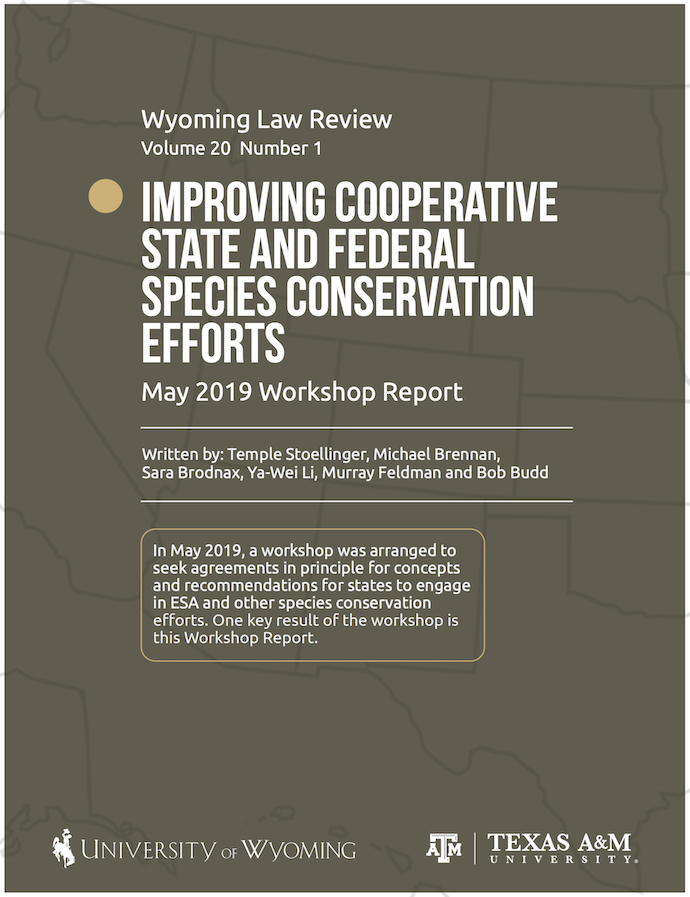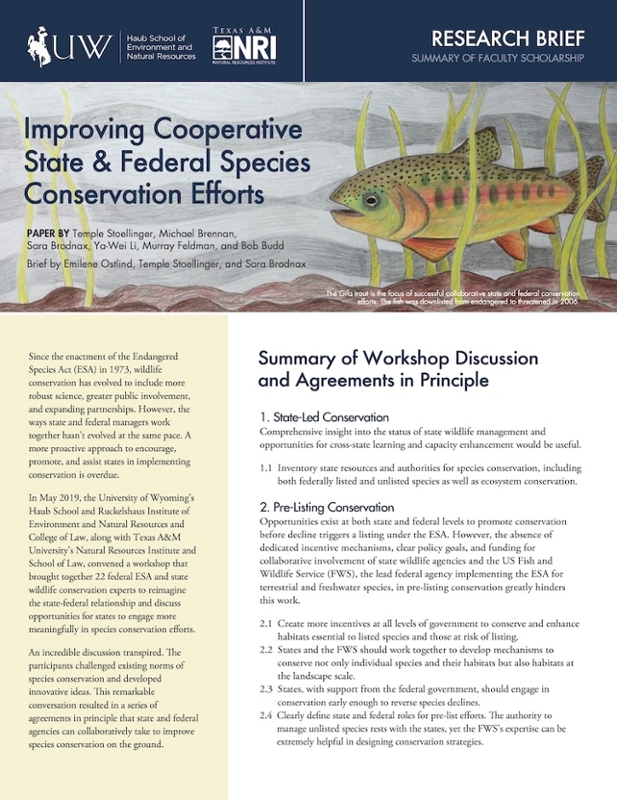

Improving Cooperative State & Federal Species Conservation Efforts
September 4, 2020
Workshop on State and Federal Cooperation for Species Conservation
Since the enactment of the Endangered Species Act (ESA) in 1973, wildlife conservation has evolved to include more robust science, greater public involvement, and expanding partnerships. However, the ways state and federal managers work together hasn't evolved at the same pace. A more proactive approach to encourage, promote, and assist states in implementing conservation is overdue.
In May 2019, the University of Wyoming's Haub School of Environment and Natural Resources and College of Law, along with Texas A&M University's Natural Resources Institute and School of Law, convened a workshop that brought together 22 federal ESA and state wildlife conservation experts to reimagine the state-federal relationship and discuss opportunities for states to engage more meaningfully in species conservation efforts.
An incredible discussion transpired. The participants challenges existing norms of species conservation and developed innovative ideas. This remarkable conversation resulted in a series of agreements in principle that state and federal agencies can collaboratively take to improve species conservation on the ground.
"Regardless of perspective, the state-federal relationship must be well thought out and grounded in the goals of ensuring species protection by restoring imperiled species and conserving our broader wildlife heritage."
Above: The Gila trout is the focus of successful collaborative state and federal conservation efforts. The fish was downlisted from endangered to threatened in 2006.
Workshop Participants
- Leslie Allison, Western Landowners Alliance
- Drew Bennett, UW Haub School of ENR
- Zach Bodhane, Western Governors’ Association
- Jim Bradbury, Texas A&M College of Law
- Michael Brennan, Texas A&M Natural Resource Institute
- Sara Brodnax, Environmental Defense Fund
- Bob Budd, Wyoming Wildlife & Natural Resource Trust
- Myles Culhane, Occidental Petroleum
- Murray Feldman, Holland & Hart LLP
- Gary Frazer, U.S. Fish and Wildlife Service
- Sam Kalen, UW College of Law
- David Klute, Colorado Parks and Wildlife
- Ya-Wei (Jake) Li, Environmental Policy Innovation Center
- Roel Lopez, Texas A&M Natural Resource Institute
- Gordon Myers, North Carolina Wildlife Resources Commission
- Steve Quarles, Nossaman LLP
- Mark Rupp, Environmental Defense Fund
- Bill Schenk, Montana Department of Fish, Wildlife and Parks
- Steve Smutko, University of Wyoming Haub School of ENR
- Temple Stoellinger, UW Haub School of ENR/College of Law
- John Swartout, Colorado Counties, Inc.
- David Willms, National Wildlife Federation

For many species, particularly those that occur primarily on nonfederal lands, states have led recovery implementation. In 2018, conservation carried out by Utah state agencies helped move the deseret milkvetch off of the federal list of endangered and threatened plants.
Summary of Agreements in Principle
The workshop’s objective was to seek agreements in principle, not necessarily consensus. Accordingly, these agreements in principle should not be interpreted as binding on any workshop participant. Rather, they should be interpreted as concepts or recommendations the participants found generally acceptable.
1. State-Led Conservation
Comprehensive insight into the status of state wildlife management and opportunities for cross-state learning and capacity enhancement would be useful.
1.1 Inventory state resources and authorities for species conservation, including both federally listed and unlisted species as well as ecosystem conservation.
2. Pre-Listing Conservation
Opportunities exist at both state and federal levels to promote conservation before decline triggers a listing under the ESA. However, the absence of dedicated incentive mechanisms, clear policy goals, and funding for collaborative involvement of state wildlife agencies and the US Fish and Wildlife Service (FWS), the lead federal agency implementing the ESA for terrestrial and freshwater species, in pre-listing conservation greatly hinders this work.
2.1 Create incentives at all levels of government to conserve and enhance habitats essential to listed species and those at risk of listing.
2.2 States and the FWS should work together to develop mechanisms to conserve not only individual species and their habitats but also habitats at the landscape scale.
2.3 States, with support from the federal government, should engage in conservation early enough to reverse species declines.
2.4 Clearly define state and federal roles for pre-list efforts. The authority to manage unlisted species rests with the states, yet the FWS's expertise can be extremely helpful in designing conservation strategies.
3. Species Status Assessments
The FWS produces Species Status Assessments—compilations of the best available science about a species' biology, habitat, demographics, and more—to inform decisions about species' listing status. States, despite relevant expertise, have had inconsistent participation in these assessments.
3.1 Develop further FWS policy to encourage effective state involvement and engagement in Species Status Assessments. Training for both federal and state participants in communication and collaborative skills would be beneficial.
3.2 Revise current FWS guidance to direct state involvement in Species Status Assessments for not only listing efforts, but also up-listing, down-listing, and delisting activities.
3.3 The FWS should issue policy that recognize the circumstances in which state-led assessment efforts would be appropriate.
4. 4(d) Rules for Threatened Species
The FWS has the ability to manage threatened species more flexibly than endangered species through the application of 4(d) rules. The FWS could engage states more often and meaningfully on opportunities to improve how species specific 4(d) rules are written and implemented.
4.1 Consider state conservation programs and laws as the basis for 4(d) exemptions where they are providing adequate conservation.
4.2 Use 4(d) rules, accompanied by state management plans, to prepare for the delisting of threatened species.
4.3 Use the process of engaging states in Species Status Assessments as a foundation for developing 4(d) rules.
4.4 Tailor protections in a 4(d) rule based on population/geographic specific conservation needs.
4.5 Develop a 4(d) national guidance document or handbook.
5. Communication
Communication between states and the FWS could be improved on both their substance and the process of gathering and including state input.
5.1 The FWS should develop procedures for engagement with state governors and responsible state agencies.
5.2 The FWS should engage with interested or affected state interests early, before formal federal decision-making processes commence.
5.3 State should submit information, comments, and data in a way that is readily documentable and useable to the FWS and other stakeholders.
6. Recovery and Delisting
To be effective, recovery plans need to reflect input from all partners, particularly state wildlife agencies. Further, opportunities exist for greater state engagement or even leadership in recovery plan implementation. Better state engagement during recovery plan development and implementation could translate to stronger assurances of post-delisting management and more defensible delisting decisions.
6.1 The FWS should develop a formalized process for states to lead recovery plan development.
6.2 The FWS should develop and offer training and outreach to states about data needs, standards, and coordination.
6.3 The FWS should clarify and strengthen the process for delisting of conservation-reliant species based on state conservation assurances.
7. Funding
States are at the front lines of species conservation. Yet less than five percent of all funding under the ESA goes to state species conservation. Funds generated by hunting and fishing are the primary revenue for most state fish and wildlife agencies, but there is no similar funding source for non-game species.
7.1 Significantly expand funding for wildlife conservation. Federal funding is necessary and should be complemented by creative state funding sources, such as state wildlife trust funds, leveraged private sources, and even funding from license plates.

The Louisiana Department of Wildlife and Fisheries worked with the FWS to develop a programmatic CCAA for the Louisiana pine snake to address the conservation needs of the species on private lands in an effort to preclude the need to list the species under the ESA.
What's Next
Following are highlights from the workshop on Improving Cooperative State and Federal Species Conservation Efforts with a discussion of the relevance for specific stakeholder groups. Our hope in featuring key agreements in principle of potential interest to these communities is to inspire action.
Non-Profit Community
There has been an ongoing discussion about the role of states in the conservation of threatened and endangered species since the passage of the ESA. Better engaging and assisting states in implementing conservation could enhance species health and recovery.
- Framing: The workshop participants agreed that the agreements in principle should not include delegating existing federal ESA authority to states and need not involve substantive amendment of the ESA itself.
- 4d Rules for Threatened Species: The recent change to the FWS’s 4(d) rule approach may cause the FWS to more frequently consider how best to tailor 4(d) protections for threatened species. The FWS should develop national guidance on 4(d) rules to help improve consistency and use of best practices.
- Funding: Participants agreed that improving both state and federal capacity for conservation is essential to species protection and recovery. Funding allocations for wildlife conservation should be significantly expanded.
Landowner and Land Manager Community
The states and federal agencies play important and complementary roles in species conservation. States in particular are well-positioned to support landowners and land managers on-the-ground.
- Pre-Listing Conservation: Proactive conservation is essential before decline triggers a listing under the ESA. Opportunities exist at both state and federal levels to promote proactive conservation. For example, the FWS can provide assurances to private landowners who enter Candidate Conservation Agreements with Assurances (CCAAs), while states can administer programmatic CCAAs as a way to effectively engage large numbers of landowners in conservation. These tools receive limited funding from either state or federal government and should be better supported. The FWS and the states could also create additional incentives to support voluntary, proactive conservation work.
- Funding: It is important to expand incentives and funding for conservation. Funds generated by hunting and fishing are the primary revenue for most state and fish wildlife agencies, but there is no similar funding source for non-game species. Both federal and state funding allocations for conservation need to be elevated.
State Wildlife Agencies
Reimagining the relationship between the states and the federal government in implementing the ESA could lead to better and more effective species conservation. States are well-positioned to help conserve species and should have a more significant role in ESA processes.
- Communication: Communication and information flow between states and the FWS could be improved. The FWS should engage early and often with states, while states should offer information and data in a way that is most useful to the FWS.
- Species Status Assessments (SSAs): States should have greater input and involvement in developing the scientific information on which listing decisions are made. FWS policy should encourage more effective state engagement in SSAs.
- Recovery and Delisting: Opportunities exist for greater state engagement or even leadership in recovery planning and implementation. State involvement and leadership in recovery plan development and implementation, delisting, and post-delisting species management is essential to achieving the ultimate purpose of the ESA, recovering species to the point where they no longer need the protections of the statute.
- Funding: It is important to expand state and federal funding allocations and capacity for conservation. Creative sources of funding for states could include state wildlife trust funds, leveraged private sources, or even funding from license plates. Better resourced State Wildlife Actions Plans could serve as a bedrock for more effective state conservation of species and habitat.
Fish and Wildlife Service
Further federal support can bolster the important and complementary role states play alongside the federal agencies tasked with implementing the ESA.
- Communication: Communication between states and the FWS could be improved on both substance and process. The FWS should engage early and often with states, while states should provide information in a way that is most useful to the FWS and ESA processes.
- Species Status Assessments (SSAs): State engagement in FWS species biological assessments is appropriate when it contributes to the science on which decisions are made. FWS should recognize the circumstances in which state contribution or even leadership of an SSA is appropriate with regard to up-listing, down-listing, and de-listing activities.
- 4(d) Rules for Threatened Species: The recent change to the FWS’s 4(d) rule approach may cause the FWS to more frequently consider how best to tailor 4(d) protections for threatened species, including through consultation with states and the public. State conservation programs and laws can be used more frequently as the basis for 4(d) rules, and 4(d) rules accompanied by a state management plan could support delisting of threatened species. National guidance on 4(d) rule development should be developed to capture best practices and ensure consistency.
- Recovery and Delisting: States are well-suited to identify and implement on-the-ground recovery actions. More state involvement or even leadership in the development and implementation of recovery plans could improve species recovery. Furthermore, state engagement in delisting could translate to stronger assurance of post-delisting management and more defensible delisting decisions.
- Funding: Both federal and state funding allocations for conservation need to be elevated.
Full ReportTemple Stoellinger, Michael Brennan, Sara Brodnax, Ya-Wei Li, Murray Feldman, and Bob Budd. "Improving Cooperative State and Federal Species Conservation Efforts." 20(1) Wyoming Law Review 183 (2020). |
|
SummaryDownload a 4-page summary of the agreements in principle and highlights for stakeholders shared on this web page. |







